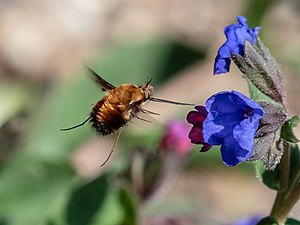Great wool floater
| Great wool floater | ||||||||||
|---|---|---|---|---|---|---|---|---|---|---|

Large wool floater ( Bombylius major ) |
||||||||||
| Systematics | ||||||||||
|
||||||||||
| Scientific name | ||||||||||
| Bombylius major | ||||||||||
| Latreille , 1802 |
The large wool swimmer ( Bombylius major ) is a species from the wool swimmer family within the order of the two-winged (Diptera).
features
The species reaches a body length of 9 to 12 millimeters. The body is hairy from the head to the abdomen and also on the sides thickly furry brown to yellowish-beige. There are upright yellowish to sand-colored hairs on the mesonotum and scutellum . The 5.5 to 7.7 millimeter long suction tube , which is usually stretched straight forward in the resting position, is striking . The dark antennae are also stretched forward and have red-brown bristles at the base. At the front edge of the wing you can see a dark, wide band that is serrated to the rear, the rear half of the wing is transparent. The thighs ( femora ), knees or the lower part of the splints ( tibia ) and tarsi are red-brown in color and have bristles. The claws and their pulvilli are rather small.
Similar species
The large wool swimmer can easily be confused with the larger spotted wool swimmer ( Bombylius discolor ), which has dark-spotted wings. The large wool swimmer can also be easily distinguished from similar species by the black hair at the back of the eye.
Occurrence and habitat
The species is widespread in Europe, North Africa, Asia and North America. They can be found on the edges of paths and forests, clearings, meadows and occasionally in gardens, mostly near colonies of solitary bees and digger wasps . They are common and widespread, the flight time is from April to June.
Way of life
The larvae develop parasitoidly , among other things they feed on larvae of solitary bees, digger wasps and certain butterflies, such as owl butterfly species .
The adults, on the other hand, only consume nectar, which they suck in, similar to hummingbirds. They can fly considerably quickly when heated up in the sun and are very agile. Males show territorial behavior because they defend preferred seating to wait for females there. During mating, which lasts a few minutes, males and females are connected by the tips of the abdomen. After mating, the female lays the pale yellow, rice-grain-shaped and approximately 0.5 millimeter eggs in front of the entrances to the host's nests; it wets the eggs with sand to protect them. The hatched and very agile larvae penetrate the host's nests independently and feed first on the supplies and later on the host larvae. The larvae of the large wool swimmers are initially equipped with flexible legs, after the first molt they have a maggot-like, legless shape and can only move with difficulty. They overwinter as a pupa , the adults hatch from March.
Large wool float floating on coltsfoot ( Tussilago farfara )
Large wool floater on candytuft
When sunbathing (video, 2m 10s)
swell
literature
- Galathea. Reports of the Nuremberg Entomologists Association Volume 10, Issue 2, 1994.
- Joachim & Hiroko Haupt: Flies and mosquitoes: observation, way of life. Naturbuch-Verlag, Augsburg 1998, ISBN 3-89440-278-4 .
- World Catalog of Bee Flies. Backhuys Publishers, Leiden ISBN 90-5782-039-0 .
- Klaus von der Dunk: Red list of endangered wool floaters (Bombyliidae) in Bavaria. Bavarian State Office for Environmental Protection, 1992.
- Klaus von der Dunk: Zweiflügler from Bavaria IV. In: Entomofauna.





